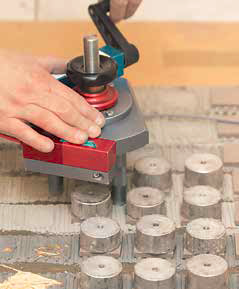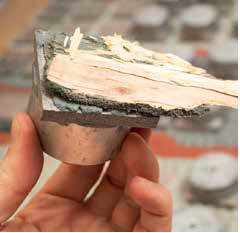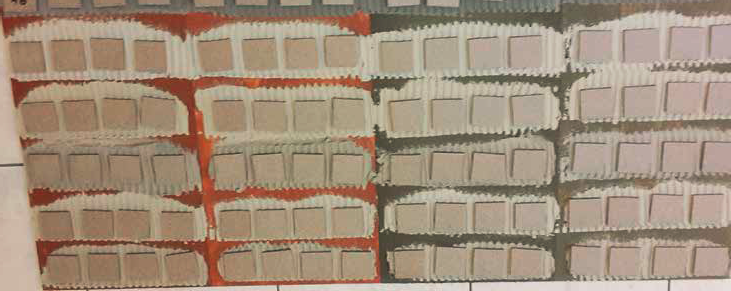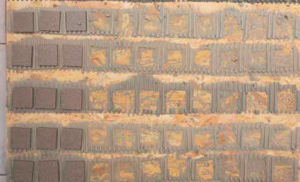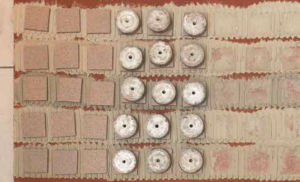Fixing ceramic tiles upon OSB substrates can cause problems due to the material characteristics. Boards may swell or delaminate under prolonged influence of moisture which in result can lead to weakening or even destruction of the adhesive bonding. OSB does not always keep its dimensions when subject to altering moisture level – this is particularly visible at the construction site where the boards are cut. Because of all the reasons above, OSB is classified as so-called difficult substrate and requires specific technological regime.
|
Reasons for difficulties – OSB boards have relatively smooth surface as they are varnished or covered with paraffin during manufacturing; – OSB boards have low water absorption, which results from the use of synthetic resin as a binder for sealing the board; – the structure consists of a large amount of chips tightly compressed, one next to the other – the material structure is composite. Therefore the board may be vulnerable to delamination in its cross-section. |
Recommended technology
Fixing ceramic tiles upon OSB boards entails systemic approach, compliance with the rules of bonding techniques and appropriate materials selection – they should be adequate to this specific type of substrate. The highest inter-coat bonding is obtained if one applies the following principles:
– check the type and thickness of the boards – it is assumed that the substrate for tiles can be constructed of OSB/3 or OSB/4 types of boards of minimum thickness of 25 mm (on floors) and 18 mm (on walls),
– check the stability of OSB sheathing fixed to the load-bearing structure – boards cannot curl when under pressure,
– roughen the surface of boards with the use of sand paper of 40-60 grit size,
– clean the surface from dust which was produced during grinding,
– apply a contact coat,
– use the adhesive of C2 type (with improved bonding to the substrate) and S1 class (deformable),
– bond the boards with basic or combined method (obligatorily on floors, optionally on walls and other vertical elements).
The technology described above works well in practice, but may be fraught with risks arising from already mentioned fragility of OSB dimensions and shape in case of long-lasting moisture action. This applies in particular to claddings located in wet rooms, where, due to operating conditions, moisture can occur beneath the tiles. It also applies to some unusual situations, e.g. failure of plumbing system.
|
Contact coat It is formed by coating applied upon the substrate, which forms strongly adhering layer when dries. Typically, the material for contact coat contains an additive in the form of fine quartz aggregate, which forms rough surface when dries. Owing to the presence of aggregate the contact area between the substrate and freshly applied layer of material, e.g. adhesive for tiles, improves significantly. Therefore, the primary function of the contact coat is to improve the interlayer bonding. In addition, it separates both layers. It is used for example on substrates: of low water absorption, e.g. concrete, extremely smooth or covered with remains of old adhesives, PVC and paints, etc. The perfect example |
TEST Adhesion to OSB: adhesives for tiles of C2 type
Below we present a description, results and conclusions of the examination carried out in our laboratory to determine the best tiling technology upon the substrate made of OSB. The test compared the bonding of adhesives of C2 type to the substrate made of OSB and prepared with different methods.
Aim of examination
Prolonged influence of moisture may lead to OSB swelling (increase of volume without cohesion violation), or even
delamination of cross-section. Due to OSB instability in such situations, the connection is gradually degraded, even
if appropriate technology of works is applied and the adhesive of enhanced parameters (C2 type) is used.
For this reason, we decided to check the performance of waterproofing materials when attached to OSB. Owing to their properties, these materials provide permanent separation of boards from humidity – the factor causing problems.
At the same time the test was performed in order to confirm that the waterproofing coat forms a suitable contact coat, which improves the bonding of adhesive for tiles to OSB boards.
Basic concepts
For testing we used OSB/3 board which surface was prepared in one of seven ways:
1. “Raw” board, left without any further preparation or priming;
2. The board was grinded and dedusted
3. The board was grinded, dedusted and covered with contact coat (made of polymer dispersion, containing quartz sand in its composition)
4. The board was grinded, dedusted and covered with one layer of one-component waterproofing
5. The board was grinded, dedusted and covered with two layers of one-component waterproofing
6. The board was grinded, dedusted and covered with one layer of two-component waterproofing
7. The board was grinded, dedusted and covered with two layers of two-component waterproofing
Test conditions
Ceramic tiles were bonded with cement adhesives for tiles of C2 type with improved performance. Owing to the use of adhesives produced by different manufacturers, we were able to compare how the test results change because of varying composition, parameters and adhesive properties. The test was performed under laboratory conditions, according to the standardized methodology – PN-EN 1348 “Adhesives for tiles. Determination of tensile adhesion strength for cementitious adhesives” standard and the same boundary conditions:
– constant temperature and humidity in the room,
– the same type of ceramic tiles of dimensions complying with the standard,
– the ratio and method of mixing the adhesive with water according to the manufacturer’s guidelines,
– use of trowel of the same size of notches for each of the adhesives.
Course of examination
1. The adhesive was applied with a standard method – spread with a notched trowel upon the substrate.
2. After 5 minute break (before the adhesive started to harden on the surface) the tiles were applied.
3. When the adhesive fully dried, each of the tiles was loaded with the force of 20 N (2 kg weight) for 30 seconds. For this purpose, special metal discs were attached to the tiles. Discs are designed for pull-out tests. They have special connectors for attaching the strength testing machine.
4. Bonding examination was done with a strength testing machine in accordance with the aforementioned standardized requirements. To avoid any bending force the pulling was performed axially and evenly.
The results of laboratory tests
Performed laboratory tests and measurements allowed us for a coherent and reliable comparison between different methods of OSB preparation and their relation with reached bonding level. The results are given in the table below. They vary depending on the method of substrate preparation and adhesive type.
Table 1. Bonding to the substrate [N/mm2] obtained after 28 days
|
No. |
Substrate |
Adhesive no. 1 |
Adhesive no. 2 |
Adhesive no. 3 |
Adhesive no. 4 |
Adhesive no. 5 |
|
1. |
OSB – raw |
– |
– |
– |
– |
– |
|
2. |
OSB – grinded |
– |
0.08 |
0.11 |
0.10 |
– |
|
3. |
OSB – contact coat |
0.19 |
0.33 |
0.33 |
0.35 |
0.21 |
|
4. |
I coating of Woder W |
0.27 |
0.35 |
0.37 |
0.38 |
0.24 |
|
5. |
II coating of Woder W |
0.40 |
0.40 |
0.36 |
0.44 |
0.30 |
|
6. |
I coating of Woder Duo |
0.63 |
0.49 |
0.58 |
0.50 |
0.36 |
|
7. |
II coating of Woder Duo |
0.65 |
0.54 |
0.56 |
0.68 |
0.36 |
Comparison of the test results shows that the highest adhesion was obtained for adhesive no. 1 and 4,
slightly lower for adhesives 2 and 3, and the lowest for the 5th adhesive. In addition, adhesive no. 5 got the lowest results in all 7 tests. Adhesive 1 did not provide the recommended bonding level in most of the arrangements, but finally it performed very well with the OSB substrate covered with ATLAS Woder Duo, both for a single or double coating. All of the adhesives showed a significant increase in adhesion when two-component ATLAS Woder Duo waterproofing was in use.
|
Bonding coat It is formed by material mass which should be strongly and intensely rubbed into the substrate, so it tightly fills the existing pores and cavities. The rule is to apply the consecutive material layer before the bonding coat dries – in other words one should use the “wet on wet” method of application. Therefore, the function of the bonding coat is to improve the interlayer bonding, but at the same time to ensure a homogeneous bonding between the layers. The use of bonding coat increases the connection tear resistance. A so-called base coat is an example of a bonding coat. It is usually applied upon walls before the thick-coat cement plasters e.g. Atlas Plastering Mix or Atlas Light Machine-applied Plaster. Bonding coat ensures more favorable operating conditions for the layers arrangement, as the contact coat improves the bonding only. Bonding coat is required in case of some cement mortars, for example mortars of ATLAS Postar line or ATLAS ZW330 Leveling Mortar. |
Conclusion
1. The pull-out test results clearly show that the OSB substrate provides virtually no bonding even for adhesives of C2 type, regardless it is raw or grinded. As satisfactory bonding one can presume the minimum of 0.3 N/mm2. This is the lowest accepted value of bonding which provides reasonably safe operation of cladding in residential buildings.
2. In case of OSB substrate covered with a contact coat, the average result obtained for different adhesives is approx. 0.3 N/mm2. Although in the case of two adhesives (samples no. 1 and no. 5), the results are still below expectations. More preferable bonding results were obtained when the surface was covered with one or two layers of waterproofing.
3. In regard to different waterproofing products: slightly lower results were obtained when one-component ATLAS Woder W water-proofing was in use, and much higher when we used two-component ATLAS Woder Duo waterproofing. In both cases the difference between the application of one or two coatings of waterproofing was not relevant for the final bonding value.
4. Therefore, in the case of OSB one can assume, that the best contact coat for this type of substrate is constituted by a single coating of Atlas Woder Duo. It provides the most durable adhesive bonding resulting from the highest bonding to the substrate. At the same time, the waterproofing coating provides sufficient protection of OSB against moisture caused by water action without pressure. To sum up, two major conditions of proper waterproofing are met – high interlayer bonding and lack of possibility of moisture ingress.
5. After completing the aforementioned tests, we can strongly recommend ATLAS Woder Duo as the best choice for a contact coat when OSB substrate is in use. This is a new and somewhat unusual use for this product. However, it can be
considered as an alternative to the technology already recommended by ATLAS – using ATLAS Grunto-Plast mass as a contact coat.
6 We recommend using adhesives with improved adhesion (C2 type) on OSB substrates.
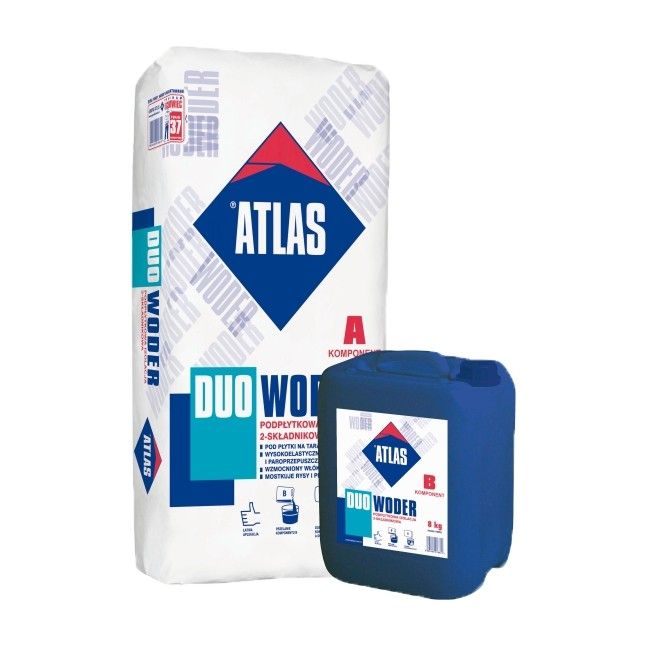 |
ATLAS Woder Duo waterproofing
– Flexible |
Tests summary
One cannot assume in advance that only the use of better and more expensive adhesives provides the adequate strength of the adhesive bonding. This is confirmed by tests made with the use upon the same substrate of the C2 adhesives offered by different manufacturers. The obtained bonding is always a derivative of substrate characteristics and parameters, but even more importantly, the method of preparation before the start of work, rather than just the parameters of the tile adhesive. It is particularly important in case of OSB substrates (especially floors) in “wet rooms”.
Original text: Sebastian Czernik, ATLAS Group
English text: Piotr Marciniak, ATLAS Group
